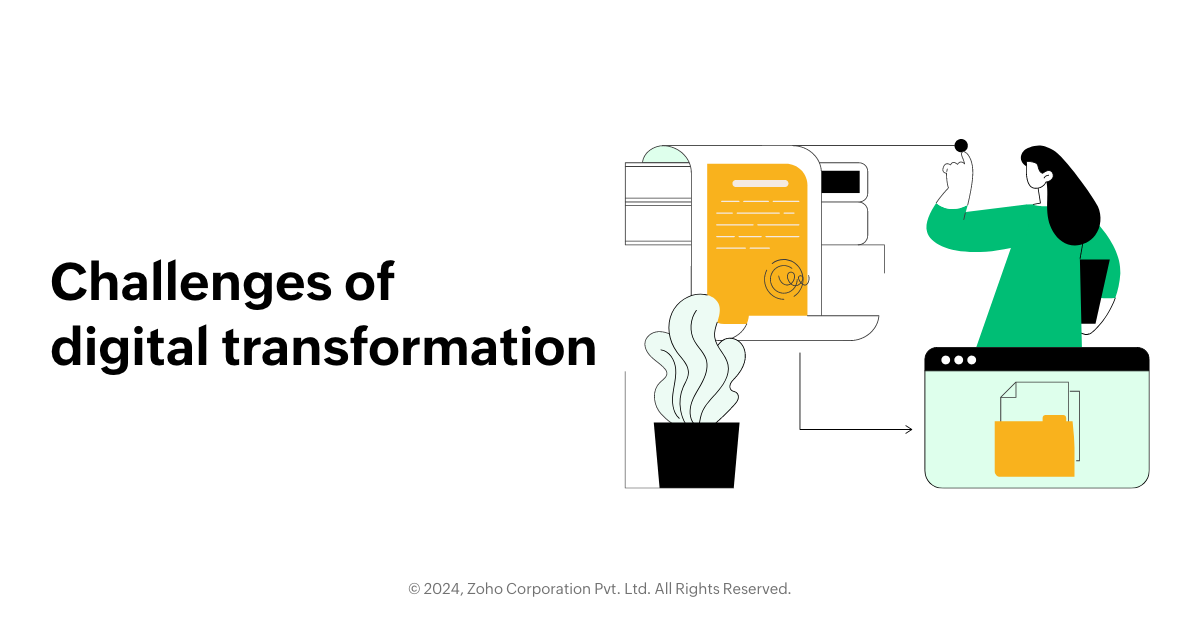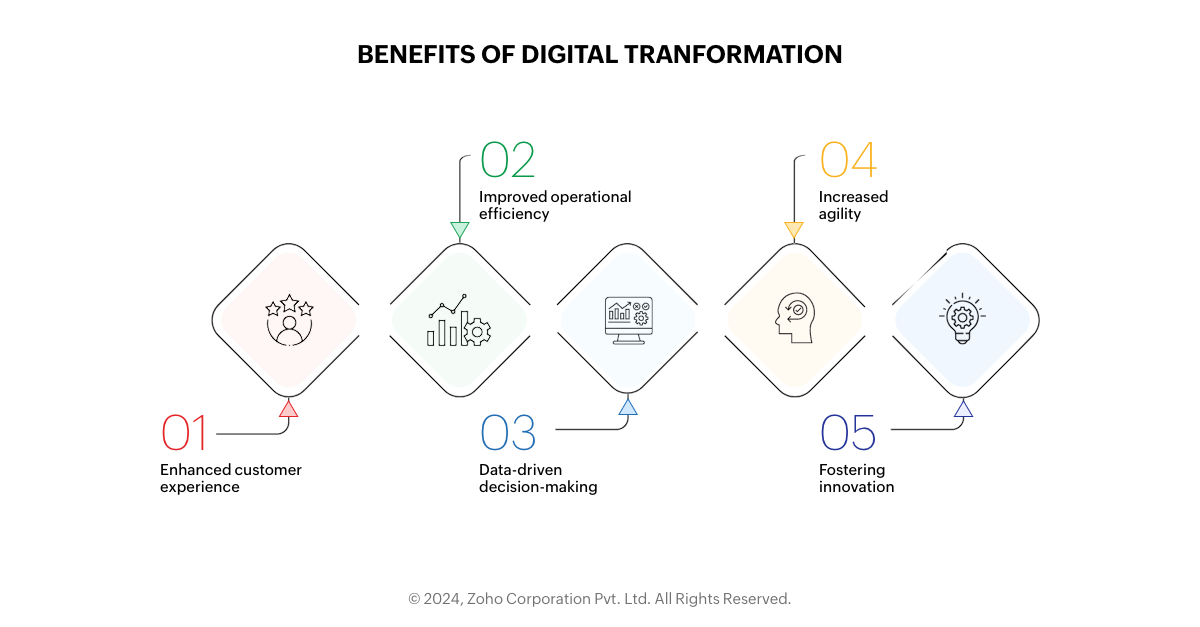- HOME
- Digital Transformation
- Don't get left behind: 5 benefits to embracing digital transformation
Don't get left behind: 5 benefits to embracing digital transformation
- Last Updated: March 29, 2024
- 337 Views
- 5 Min Read

Imagine you walk into your favorite store, only to find it's stuck in the past—paper forms, manual inventory checks, and long wait times. Frustrating, right? Customers in the modern world have high expectations for a smooth and effective experience in the digital realm. That's where digital transformation comes in.
Digital transformation is the process of leveraging digital technology to enhance how a business' operations function. It's not just about flashy gadgets; it's about using digital processes and embracing change to thrive in a constantly evolving landscape.
Why companies need to digitally transform
The digital landscape is like a rushing river; it's constantly changing. Customer expectations are evolving rapidly thanks to advancements in technology. They expect personalized experiences, instant access to information, and convenient online ordering. Businesses that cling to outdated methods risk getting swept away by the current.
Staying competitive requires constant adaptation and innovation. Digital transformation efforts equip businesses with the tools to do that. It allows them to experiment with new ideas, respond quickly to market changes, take competitive advantage, and stay ahead of the curve. And let's not forget the threat of disruption. New, digitally-native competitors are popping up all the time, ready to steal your market share if you're not careful.

Embracing change isn't always easy. Employees might be apprehensive about new technologies and the impact on their roles. Effective change management is crucial to address these anxieties and ensure a smooth transition for digital growth.
Another hurdle can be legacy systems. Integrating shiny new tools with outdated infrastructure can be complex and time-consuming. Finally, data security is a top priority during the digital transformation journey. Businesses need robust plans to protect sensitive customer information.
Data silos and integration headaches: Organizations often face challenges with data that is isolated in different departments. To undergo digital transformation, these silos must be dismantled and data from various sources must be integrated. This can be a difficult and lengthy process that requires careful planning and data management strategies.
The talent gap and reskilling needs: Digital transformation often necessitates a shift in skillsets for employees. Businesses may face a talent gap as they need workers with expertise in new technologies and data analysis. Addressing this challenge requires robust reskilling and upskilling programs to equip existing employees, but doing so enables future digital growth.
The human factor: Change management is important for a successful digital transformation campaign, but that means overcoming the human factor: peoples' resistance to change. Employees may be worried about learning new technologies or losing their jobs. To ensure support from employees and reduce resistance to digital transformation, effective communication, training, and addressing employee concerns are crucial.
Cybersecurity risks in a connected world: Digital transformation exposes businesses to a larger attack surface. Integrating new digital technologies and processes can create vulnerabilities that cybercriminals can exploit. Robust cybersecurity measures—including ongoing employee training and data security protocols—are vital to mitigate these risks.
The ethical conundrum of automation and AI: As businesses embrace automation and artificial intelligence (AI), ethical considerations arise. These include potential job displacement, bias in algorithms and machine learning, and data privacy concerns. Addressing these issues requires careful planning and a commitment to ethical AI development and deployment practices.
Digital transformation benefits
Enhanced customer experience: Digital transformation empowers you to create a frictionless and satisfying customer journey. Think personalized recommendations, self-service portals, and efficient online transactions.
Improved operational efficiency: Automating repetitive tasks will free up your employees to focus on more productive initiatives. Streamlined workflows and optimized resource allocation lead to increased productivity and reduced costs.
Data-driven decision-making: Stop relying on gut feelings. Digital transformation helps you collect, analyze, and interpret data to make informed decisions about everything from product development to marketing campaigns.
Increased agility: In today's fast-paced world, scalability to change is key. Digital transformation enables you to respond quickly to market changes, experiment with new ideas, and seize opportunities before your competitors do.
Fostering innovation: Digital tools allow for faster prototyping, testing, and deployment of new ideas. This creates a culture of innovation and experimentation, propelling your business forward.
Why you need low-code for digital transformation
Now, let's talk about how to make this transformation easier. Low-code development platforms (or simply low-code) are changing the way businesses work.
Imagine building simple applications or a software management solution without needing extensive coding expertise. That's the power of low-code. These platforms offer user-friendly interfaces that allow both technical and non-technical users to create custom apps quickly and efficiently.
Low-code empowers your team to build solutions for specific needs, accelerating innovation and bringing ideas to life faster. It also reduces development costs and frees up valuable IT resources to focus on complex, strategic initiatives. Some more benefits include:
Citizen developers and business alignment: Low-code fosters collaboration by empowering citizen developers—business users who can build simple applications to address specific needs. This bridges the gap between IT and business teams, ensuring solutions align directly with business objectives.
Improved user experience with drag-and-drop design: Many low-code platforms offer intuitive drag-and-drop interfaces for building user interfaces (UIs). This allows businesses to create user-friendly and visually appealing applications without needing design expertise, ultimately enhancing the overall user experience (UX).
Faster prototyping and iterations: Low-code development allows for rapid prototyping of new ideas. Businesses can create basic versions of applications quickly, test them with users, and iterate based on feedback. This iterative approach reduces development risk and ensures the final product meets user needs.
Integration with existing systems: Many low-code platforms offer pre-built integrations with popular enterprise applications. This simplifies the process of connecting your new low-code apps to existing systems, minimizing disruption and ensuring data flows smoothly across your business to model the entire IT ecosystem.
Scalability for future digital growth: Low-code solutions often offer built-in scalability, allowing businesses to easily adapt their applications as their needs evolve. This ensures your low-code solutions can grow alongside your business without requiring a complete rebuild.
Digitally transform your business
Digital transformation isn't just a trend; it's a necessity for businesses of all sizes. By embracing change and leveraging the power of digital solutions, you can unlock revenue streams and ensure your company thrives in the digital age. So, take the plunge, embrace digital transformation, and watch your business transform!




